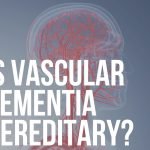Vascular dementia is one of the most common types of dementia, and people who have this illness often have to go through several vascular dementia stages.
It is a disease that develops when the brain cells die because they are not getting enough nutrients and oxygen.
It can happen when there are impaired tiny blood vessels in the brain or after a person has gone through a major stroke or even a series of smaller strokes.
Because the condition does not have a cure yet, it progresses from a mild case to a severe one. Note that these stages will differ from one person to the next.
This is simply because this type of dementia is typically brought about by different conditions.
One person may experience vascular dementia following a stroke.
However, another may get it after the inner parts of the brain get damaged for one reason or another. Just like other forms of dementia, vascular dementia also tends to progress in gradual stages. This, however, happens in a more step-like manner.
Check out how the illness may affect an individual over time describing what happens during the three major vascular dementia stages below.
Contents
Vascular Dementia Stages
1st Stage

At the onset of vascular dementia, things are usually not too serious. Many individuals during this first stage can go about their daily lives without any interference.
This is because the symptoms are still somewhat stable; thus, manageable.
Most of the time, it is difficult to tell whether a person has vascular dementia or Alzheimer’s disease.
Some people may even have what is known as mixed dementia, where one has both Alzheimer’s disease and dementia.
Some people may experience things like impaired memory (general forgetfulness), challenges finding the right words, and difficulty with planning, organizing, and carrying out several tasks in an efficient manner during the first stages of this illness.
A small percentage of individuals with vascular dementia will also go through a slight decline in walking and balance. The condition at this point may also affect thinking and decision making.
At this stage, a majority of people can live alone, but it is recommended that their loved ones always check on them often.
This helps to make sure that everything is in place and that the individuals are not a danger to themselves or any other people around them.
At times, small home modifications may also come in handy to create a more supportive and comfortable environment for individuals with vascular dementia.
2nd Stage

After a person has gone through the initial vascular dementia stages, it may reach a point where the symptoms are no longer stable.
Things become worse where you might find that the affected person now has a different personality.
Depending on the cause of this dementia, many people will start going through anxiety, depression and have mood swings.
This usually occurs because a person is more aware of the changes that are happening to their bodies. Some people will become overly emotional and a majority are prone to apathy.
Other behavioral changes may include increased agitation and irritability.
Increased agitation and irritability
There may also be sessions where they are certain outbursts where a person can either cry or laugh inappropriately.
Hallucinations and delusions may also be part of the equation.
In severe cases, a percentage of individuals who have vascular dementia will also experience epilepsy episodes. Loss of social skills is also common at this stage.
You may find that a person who has the disease no longer wants to be a part of the social circles they were in before. They may not want to talk to the people they love.
You may notice that they want to spend more time indoors as a means of shutting out the world.
Most of the time, this usually comes about because a person is embarrassed about what they are going through seeing that they are no longer in complete control of their lives.
Several physical signs may also be prevalent during the middle stages of vascular dementia.
This is where a person may experience loss of bowel or bladder control. Some may also experience dizziness and tremors often.
Caregivers may also notice that the persons under their care are experiencing arm and leg weakness and maybe moving around with shuffling rapid steps.
Language and speech problems
If a person was speaking well in the past, slurred speech and other language problems might also start to show up.
Individuals with this illness should also get close monitoring when they are on the move. That’s because they tend to get lost even when they are in familiar surroundings.
Doing things like paying bills handling money or engaging in their favorite hobby becomes challenging, which can prove to be quite frustrating to the ill individual.
It’s not uncommon for a person with the illness to have difficulties sleeping during this phase.
Some individuals also display repetitive, obsessive or even impulsive behavior.
If a person is staying alone at this point, it would be best to make different housing arrangements.
They can move in with relatives who will act as caregivers and also keep an eye on the persons with the illness to prevent avoidable accidents.
If this is not possible, the family might have to look into senior care facilities where persons with vascular dementia will get professional care.
This is simply because a person at this point may need support with multiple day-to-day activities.
These may include showering, walking, dressing, eating, cooking, and using the restroom, among others.
3rd Stage

You can consider this one of the final vascular dementia stages. The symptoms that persons experience at this stage are normally severe.
These can be distressing to the weak person.
If one gets vascular dementia after suffering a stroke, the aftermath can bring out physical symptoms.
They can experience problems with speech, vision, and weakness of the limbs. These symptoms will surface if the stroke caused damage to certain parts of the brain.
Individuals who have vascular dementia may also experience similar symptoms to the people who are in their last stages of Alzheimer’s disease.
It is where issues with communication, reasoning, confusion, memory loss, and disorientation become worse.
Motor challenges
A majority of people with vascular dementia also experience motor symptoms that may include unsteady or slow gait disturbance and clumsiness.
Handling daily activities becomes increasingly difficult, too.
Delusions or hallucinations that would come and go during the previous stage worsen.
At times, persons with vascular dementia may also become violent, suspicious, and demanding of people who are around them.
Many persons have a difficult time eating and swallowing. This often leads to rapid unhealthy weight loss. Some may even experience loss of speech.
Almost everyone at this point will have significant problems with both long-term and short-term memory.
As the condition becomes worse, it may affect/damage all the functions of the brain. This is also the stage where the illness deteriorates and can end up being fatal.
Some people at this stage can also go through heart attacks or a major stroke that can end their lives.
During this stage, it might be difficult for the family to render the appropriate care. Especially if they are not around their loved ones 24/7.
This calls for other measures such as hiring a professional who will move in to look after the person who has vascular dementia.
Alternatively, the individual might have to move into a senior care community.
A place that looks after people with dementia to get the kind of assistance and care they need without compromising their health.
Closing Remarks
Anyone who has vascular dementia should not think of it as a death sentence. It is still possible to live a full life even when going through the various vascular dementia stages.
Always remember that different people will experience vascular dementia differently.
While some may go through gradual changes, others will experience a decline in cognitive abilities, which is followed closely by stability periods.
This does not last because there are other step downs in abilities and then stability for a while, and so forth. This is what is called “stepwise” or “step-like progression.”
When your grandparent manages to catch vascular dementia in its early stage, he or she can come up with an effective treatment plan.
This will slow down the illness, preventing it from becoming worse at a fast rate.
Professional doctors have the know-how to identify the underlying cause of the illness.
The expert will come up with a healthy program you can use to reduce the risk of complications that may crop up in the future.
This might include a total change in lifestyle that will slow down the progression of the disease.
Most professionals will recommend that you get moving to increase your physical fitness and blood flow. Additionally, eat a balanced diet, get on a routine, and quit smoking and drinking alcohol.
On average, reports indicate that persons with vascular dementia will live for about five years after they detect the symptoms.
There are, however, many people who have lived for more than five years.







